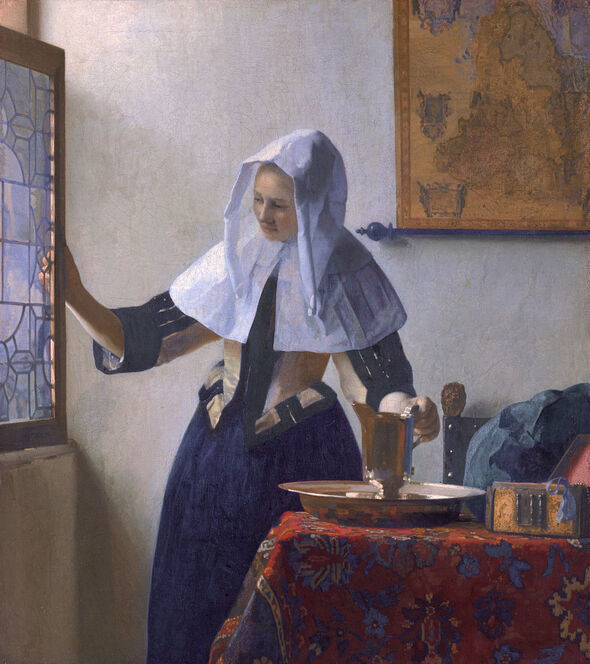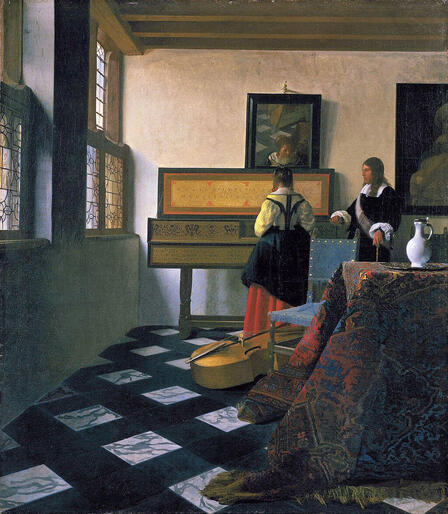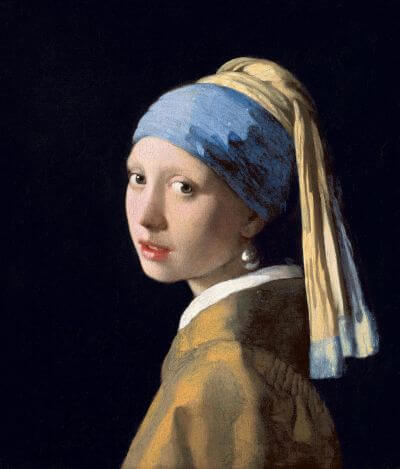|
Where? Gallery 632 of the Metropolitan Museum of Art
When? Around 1662 What do you see? A young woman opens a leaded window with her right hand, and she holds a water pitcher in her left hand. She wears a blue dress with a blue and gold-like vest (called a bodice) on top of it. She also wears a white collar and an equally white linen head covering. The silver water pitcher is standing on a silver basin. The table is covered with an expensive and colorful tablecloth with flower patterns. On the right of the table is a box with a blue ribbon and a pearl necklace. Behind the table is a chair with a carved lion on top of it. A blue cloth hangs over the chair. On the top right hangs a map of the seventeen provinces of Hapsburg Netherlands in the 17th century (interestingly, the west of Hapsburg Netherlands is shown on the top, and the north is shown on the right). The walls in this room are somewhat off-white (which is clear when seen in contrast to the head cover of the woman) and we can see the effects of the sunlight. We can recognize different shadows on the wall left of the woman, but we can, for example, also observe the shadows on the nails in the chair. The light in this painting is gently changing the colors of the various objects. It is not entirely clear what the woman is doing. It is possible that she wants to water some of the flowers that are outside the window or she may want to clean the window. Note that the window is the same as the left window in The Music Lesson by Vermeer.
Backstory: This painting is also known as Woman with a Water Jug. It is a genre painting depicting an everyday scene from the life of the 17th-century middle class in The Netherlands.
In 1887, Henry Marquand acquired this painting for $800 and later donated it to the Metropolitan Museum of Art. This was the first Vermeer painting to come to the United States. Balance and peacefulness: As in many other paintings of Vermeer, this painting shows a balanced composition which results in a very peaceful domestic scene. First, Vermeer achieves this by using a limited number of colors in this painting. He mainly uses the three primary colors: blue, red, and yellow. Second, Vermeer took many months to complete a single painting, and he added and removed various elements over that period to create the harmony that we see in this final version. For example, based on infrared technology, we know that Vermeer originally included another chair in the left foreground and the map on the wall was bigger and placed much more to the left. However, this created a more chaotic scene, and Vermeer proceeded to update the painting (check here for a virtual reconstruction of the earlier version of this painting). While removing the chair may not have been that much work, completely redoing the map on the wall on a different location was a lot of work and explains why Vermeer took such a long time to complete a painting (and the map turns out to be very accurate). Who is Vermeer? Johannes Vermeer was born in Delft, The Netherlands, in 1631 and died there in 1675. His father owned a tavern and was an art dealer. Early in his career, Vermeer got some inspiration from works by the followers of Caravaggio and especially their use of light. Vermeer developed his own style and primarily focused on genre paintings. The domestic scenes that he portrayed have become famous through their realism and excellent use of light and shadow. Besides the current painting, other examples that illustrate his brilliance are The Milkmaid in the Rijksmuseum in Amsterdam and Girl with a Pearl Earring in the Mauritshuis in The Hague. The work of Vermeer was certainly appreciated during his career, but after his death, there was a period of almost two hundred years during which his work was largely forgotten or attributed to other better-known painters. In the second half of the 19th century, his work was rediscovered and quite some well-known paintings were attributed to Vermeer.
Fun fact: As you can see in the paintings above, Vermeer used a lot of blue in his paintings. For this he used the pigment ultramarine (which is a natural pigment made from lapis lazuli). The use of this pigment differentiated him from his contemporaries as lapis lazuli was very expensive.
Most other painters used the much cheaper azurite to create blue. Lapis Lazuli is a rock with a deep blue color, and this rock was not available in Europe but had to come from countries like Afghanistan. Ultramarine is created by grinding lapis lazuli into powder and combining it with a drying oil. Titian is another well-known artist who often used ultramarine. During the Renaissance, ultramarine was primarily used to paint the robe of the Virgin Mary. The ultramarine pigment remained very expensive until 1826 when synthetic varieties of ultramarine became available. Interested in a copy for yourself? Poster
Written by Eelco Kappe
References:
0 Comments
Leave a Reply. |
Categories
All
|
- Home
- Blog
-
Museums
- Alte Pinakothek
- Art Institute of Chicago
- Baltimore Museum of Art
- Barber Institute of Fine Arts
- Bargello
- Barnes Foundation
- British Museum
- Church of Sant’Anastasia
- Cleveland Museum of Art
- Courtauld Institute of Art
- Detroit Institute of Arts
- Frans Hals Museum
- Galleria Borghese
- Gallerie dell'Accademia
- Getty Museum
- Guggenheim
- Hermitage Museum
- Kunsthistorisches Museum
- Kunstmuseum Basel
- Legion of Honor Museum
- Louvre
- Mauritshuis
- Metropolitan Museum of Art
- Musee d’Orsay
- Museum of Fine Arts in Boston
- Museum of Modern Art
- National Gallery in London
- National Gallery of Art
- National Museum in Poznań
- Norton Simon Museum
- Ny Carlsberg Glyptotek
- Palace of Versailles
- Palazzo Pitti
- Palazzo Vecchio
- Petit Palais
- Philadelphia Museum of Art
- Prado
- Pushkin Museum
- Ravenna Art Museum
- Rijksmuseum
- San Diego Museum of Art
- Santa Maria delle Grazie
- St. Peter's Basilica
- Städel Museum
- Statens Museum for Kunst
- Tate Britain
- Tate Modern
- Timken Museum of Art
- Uffizi
- Vatican Museums
- Wallace Collection
-
Artists
- Altdorfer
- Anguissola
- Berlin Painter
- Bosch
- Botticelli
- Boucher
- Bronzino
- Bruegel the Elder
- Brunelleschi
- Cabanel
- Caillebotte
- Canova
- Caravaggio
- Carpeaux
- Cezanne
- Cimabue
- David
- Degas
- Delacroix
- De Maria
- Donatello
- El Greco
- Fontana
- Fra Angelico
- Fragonard
- Gauguin
- Gentileschi
- Gericault
- Gonzalez-Torres
- Goya
- Hals
- Hogarth
- Hokusai
- Ingres
- Leonardo da Vinci
- Lippi, Filippo
- Longhi, Barbara
- Lorrain
- Makovsky
- Manet
- Massys
- Matisse
- Merian
- Michelangelo
- Mochi
- Modigliani
- Monet
- Panini
- Parmigianino
- Perugino
- Picasso
- Pisanello
- Raphael
- Rembrandt
- Renoir
- Reynolds
- Rivera
- Rodin
- Rubens
- Scultori
- Seurat
- Steen
- Tintoretto
- Titian
- Toulouse-Lautrec
- Turner
- Uccello
- Van der Weyden
- Van Dyck
- Van Eyck
- Van Gogh
- Van Hemessen
- Vasari
- Velazquez
- Vermeer
- Veronese
- Vigée Le Brun
-
Locations
- Books
- About Us




